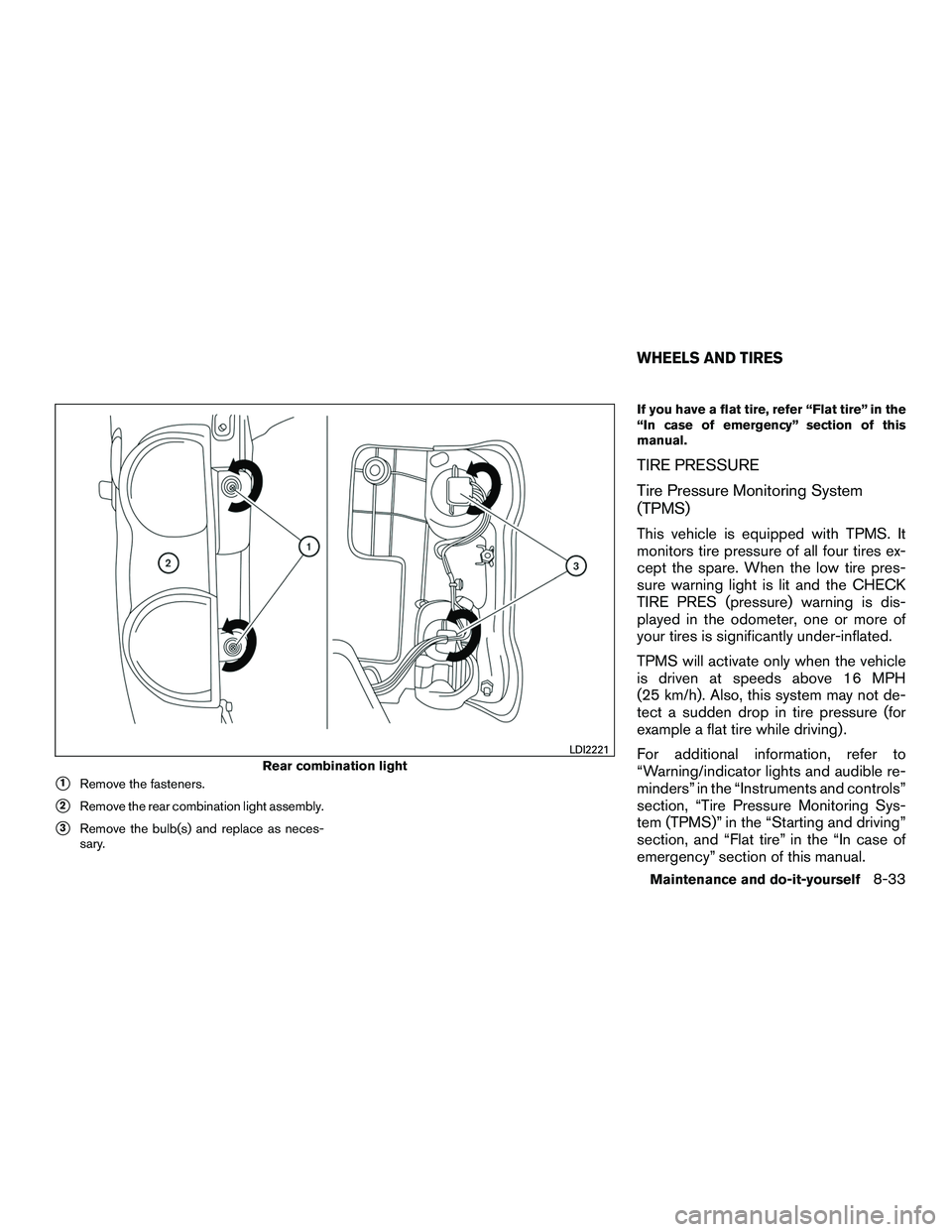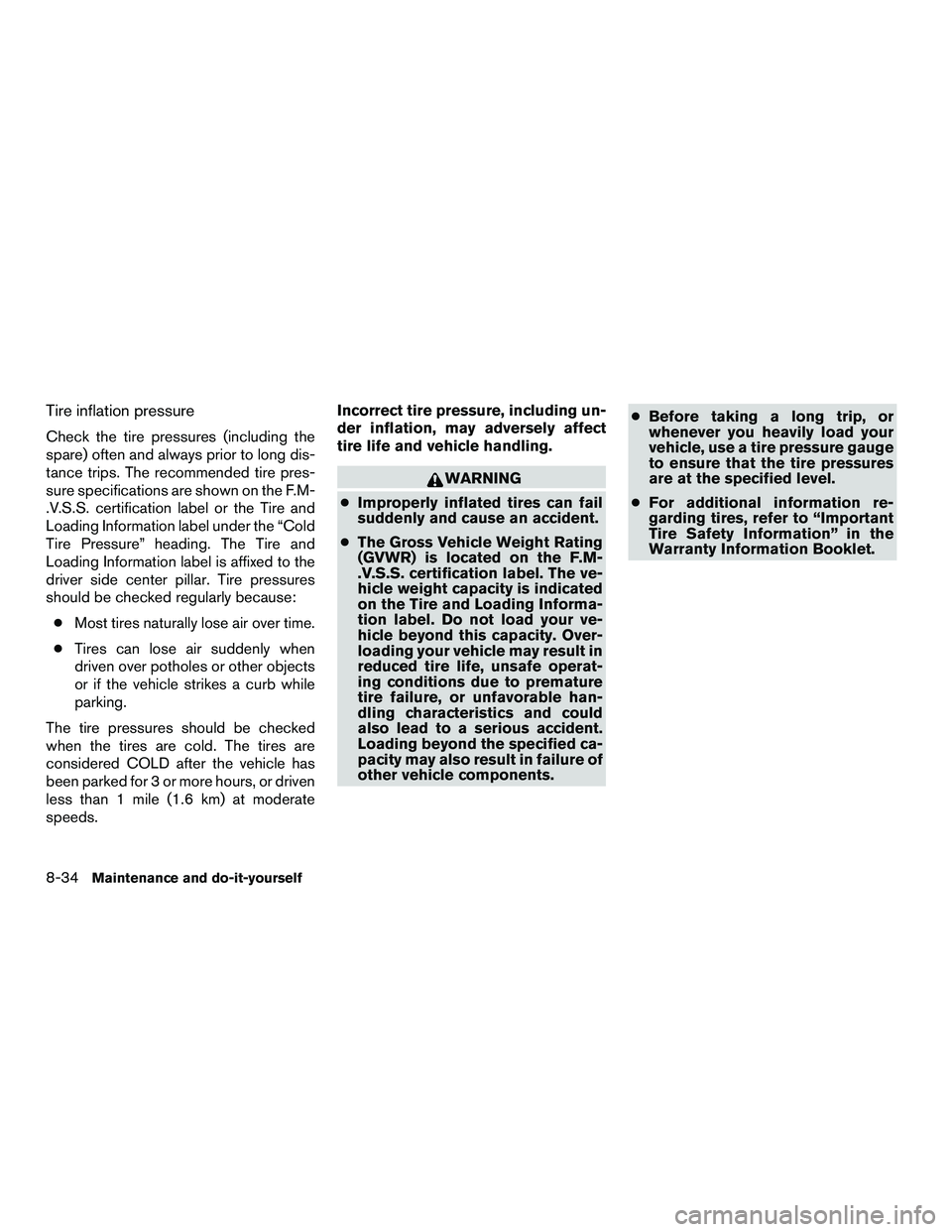Page 267 of 312
Disconnect the negative battery cable before
replacement and installation of the headlight
bulb.
�1Rotate the bulb counterclockwise and pull
out to remove. Replace as necessary.
LDI2223
8-28Maintenance and do-it-yourself
Page 268 of 312
EXTERIOR AND INTERIOR LIGHTS
ItemWattage (W)Bulb No.
Headlight assembly High/ Low 60/55H13
Park/Turn 28/83457A
High-mounted stop light* 16921
License plate light* 5T10
Rear combination light Tail/Stop 21/73047K
Backup (reversing) 16T16
Turn 273157AK
Map light 5T10
Room light 8T10
Personal light 8T10
Cargo light 5T10
Trouble light* ——
Roof light* ——
Rear exit light* ——
Always check with the Parts Department at a NISSAN dealer for the latest parts information.
* See a NISSAN dealer for replacement.
Maintenance and do-it-yourself8-29
Page 269 of 312
1. Roof light
2. Map light
3. Headlight assembly
4. High-mount stop light
5. Cargo light
6. Room light
7. Personal light
8. Rear combination light
9. License plate light
10. Rear exit light
11. Trouble light
Replacement procedures
All other lights are either type A, B, C or D. When
replacing a bulb, first remove the lens, lamp
and/or cover using a cloth and suitable tool to
protect the housing.
LDI2967WDI0263
8-30Maintenance and do-it-yourself
Page 270 of 312
Indicates bulb removal
Indicates bulb installationUse a cloth
�1to protect the housing.Use a cloth to protect the housing.
Room light
WDI0206
Personal light
LDI2283
Maintenance and do-it-yourself8-31
Page 271 of 312
Use a cloth to protect the housing.Use a cloth to protect the housing.
Map light
LDI2217
Cargo light
LDI2220
8-32Maintenance and do-it-yourself
Page 272 of 312

�1Remove the fasteners.
�2Remove the rear combination light assembly.
�3Remove the bulb(s) and replace as neces-
sary. If you have a flat tire, refer “Flat tire” in the
“In case of emergency” section of this
manual.
TIRE PRESSURE
Tire Pressure Monitoring System
(TPMS)
This vehicle is equipped with TPMS. It
monitors tire pressure of all four tires ex-
cept the spare. When the low tire pres-
sure warning light is lit and the CHECK
TIRE PRES (pressure) warning is dis-
played in the odometer, one or more of
your tires is significantly under-inflated.
TPMS will activate only when the vehicle
is driven at speeds above 16 MPH
(25 km/h). Also, this system may not de-
tect a sudden drop in tire pressure (for
example a flat tire while driving) .
For additional information, refer to
“Warning/indicator lights and audible re-
minders” in the “Instruments and controls”
section, “Tire Pressure Monitoring Sys-
tem (TPMS)” in the “Starting and driving”
section, and “Flat tire” in the “In case of
emergency” section of this manual.
Rear combination light
LDI2221
WHEELS AND TIRES
Maintenance and do-it-yourself8-33
Page 273 of 312

Tire inflation pressure
Check the tire pressures (including the
spare) often and always prior to long dis-
tance trips. The recommended tire pres-
sure specifications are shown on the F.M-
.V.S.S. certification label or the Tire and
Loading Information label under the “Cold
Tire Pressure” heading. The Tire and
Loading Information label is affixed to the
driver side center pillar. Tire pressures
should be checked regularly because:● Most tires naturally lose air over time.
● Tires can lose air suddenly when
driven over potholes or other objects
or if the vehicle strikes a curb while
parking.
The tire pressures should be checked
when the tires are cold. The tires are
considered COLD after the vehicle has
been parked for 3 or more hours, or driven
less than 1 mile (1.6 km) at moderate
speeds. Incorrect tire pressure, including un-
der inflation, may adversely affect
tire life and vehicle handling.
WARNING
● Improperly inflated tires can fail
suddenly and cause an accident.
● The Gross Vehicle Weight Rating
(GVWR) is located on the F.M-
.V.S.S. certification label. The ve-
hicle weight capacity is indicated
on the Tire and Loading Informa-
tion label. Do not load your ve-
hicle beyond this capacity. Over-
loading your vehicle may result in
reduced tire life, unsafe operat-
ing conditions due to premature
tire failure, or unfavorable han-
dling characteristics and could
also lead to a serious accident.
Loading beyond the specified ca-
pacity may also result in failure of
other vehicle components. ●
Before taking a long trip, or
whenever you heavily load your
vehicle, use a tire pressure gauge
to ensure that the tire pressures
are at the specified level.
● For additional information re-
garding tires, refer to “Important
Tire Safety Information” in the
Warranty Information Booklet.
8-34
Maintenance and do-it-yourself
Page 274 of 312

Tire and loading information label
�1Seating capacity: The maximum num-
ber of occupants that can be seated
in the vehicle.
�2Vehicle load limit: For additional infor-
mation, refer to “Vehicle loading infor-
mation” in the “Technical and con-
sumer information” section of this
manual.
�3Original tire size: The size of the tires
originally installed on the vehicle at
the factory.
�4Cold tire pressure: Inflate the tires to
this pressure when the tires are cold.
Tires are considered COLD after the
vehicle has been parked for 3 or more
hours, or driven less than 1 mile
(1.6 km) at moderate speeds. The
recommended cold tire inflation is set
by the manufacturer to provide the
best balance of tire wear, vehicle
handling, driveability, tire noise, etc.,
up to the vehicle’s GVWR.
�5Tire size - refer to “Tire labeling” in
this section.
�6Spare tire size - not equipped.
Payload and replacement tire
Your vehicle is equipped with special high load
index 92 tires to carry a payload of up to
1,235 lbs (560 kg) as indicated on your tire
information placard. Some aftermarket replace-
ment tires may have lower load index ratings.
While NISSAN does not encourage you to do so,
please note that if you choose to purchase a tire
with a lower load index rating, the max payload
capacity of your vehicle will be reduced.
Please refer to replacement tire manufacturer
usage recommendations and tire pressures.
LDI2495
Maintenance and do-it-yourself8-35